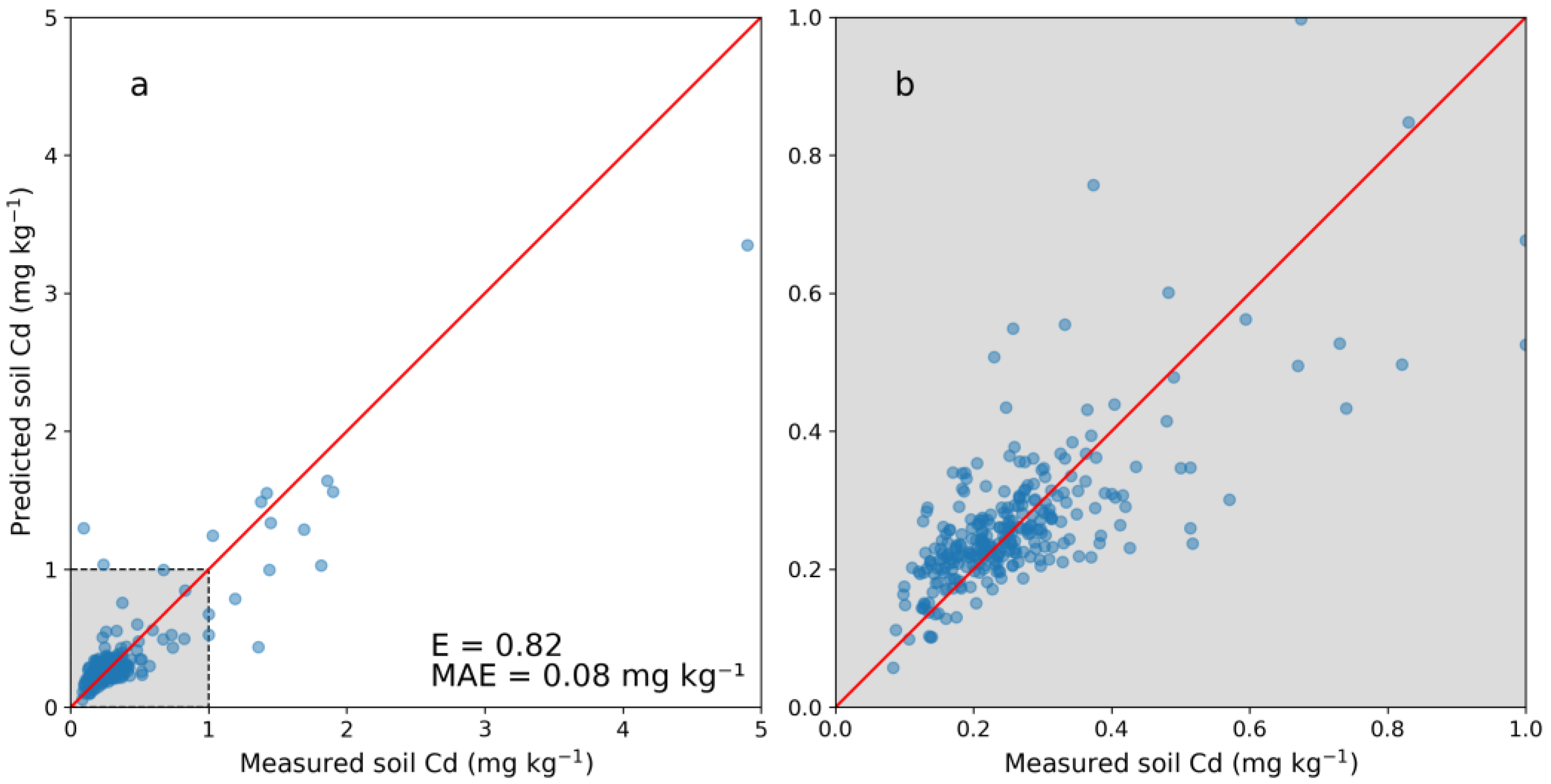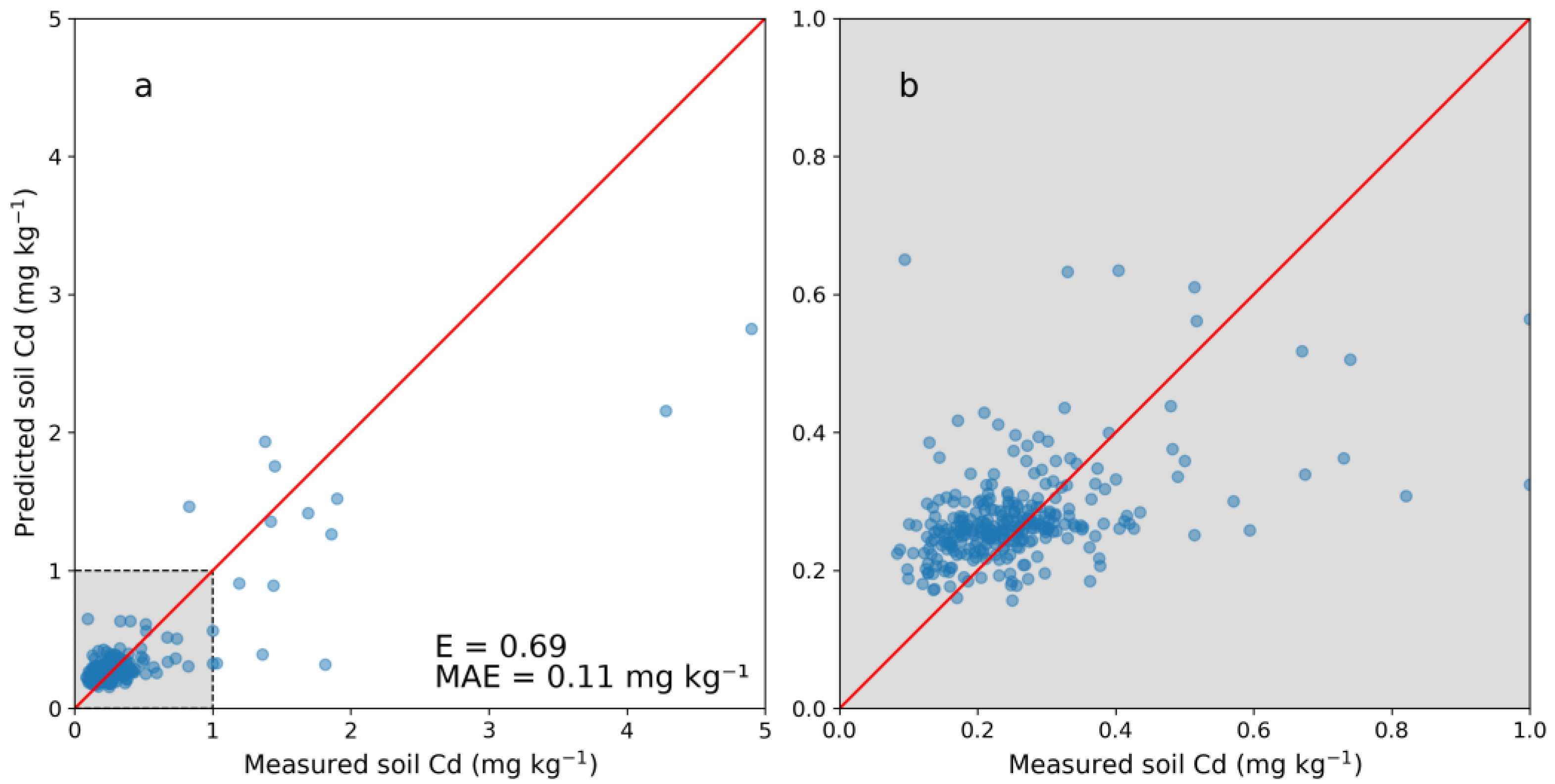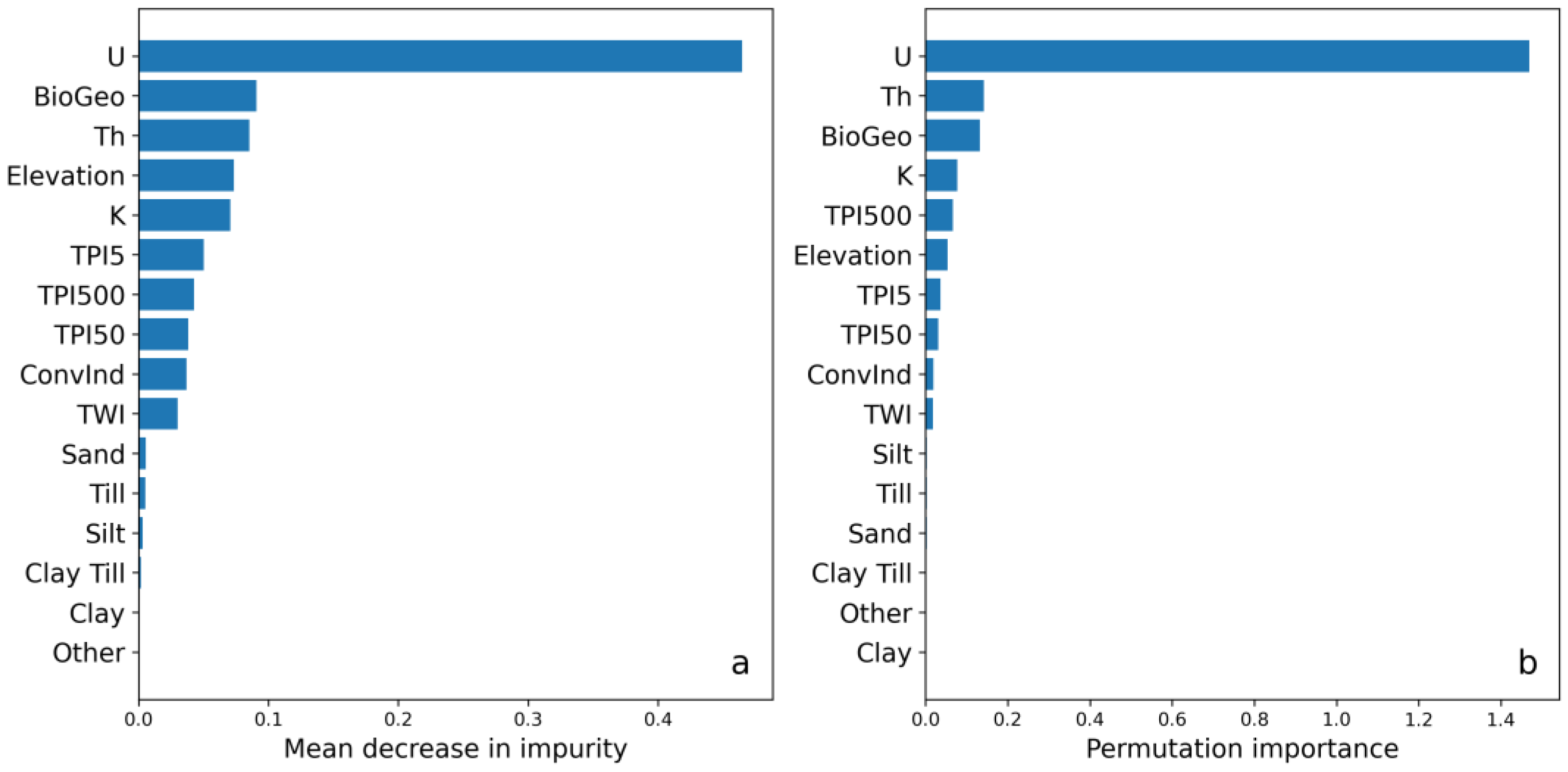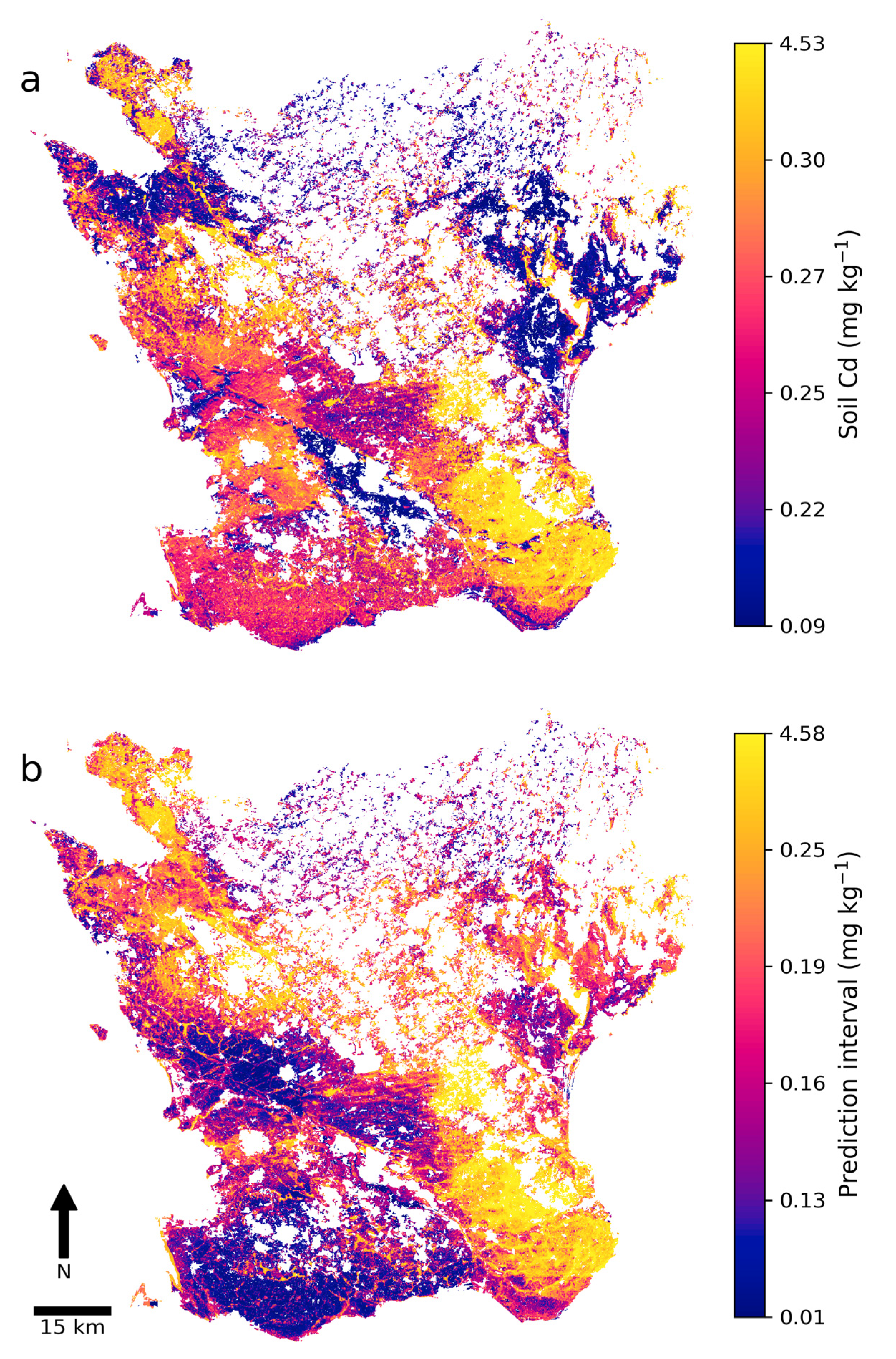Digital Soil Mapping of Cadmium: Identifying Arable Land for Producing Winter Wheat with Low Concentrations of Cadmium
Abstract
:1. Introduction
- Increase the size of the calibration dataset for the DSM model using predictions from PXRF measurements and test whether the new larger data set was better than solely using data from wet chemistry analysis for DSM model calibration.
- Employ a DSM model to create a detailed map of soil Cd (with a 50 m spatial resolution and 90% prediction intervals) using a machine learning algorithm with various covariates and covariate importance metrics and then evaluate the model’s performance by comparing its results with lab-analyzed Cd concentrations.
- Assess the applicability of the soil Cd map in identifying areas suitable for low-Cd winter wheat production by comparing winter wheat grain Cd concentrations in different parts of the map.
2. Materials and Methods
2.1. Study Area
2.2. Soil Samples and Cd Analyses
2.3. PXRF Methodology
2.4. Grain Samples
2.5. DSM Covariates
2.6. Software
2.7. PXRF Model
2.8. DSM Model
2.9. Cross-Validation and Covariate Importance
2.9.1. Cross-Validation
2.9.2. Validation Metrics
2.9.3. Covariate Importance
2.10. Identifying Areas Suitable for Winter Wheat Production
3. Results
3.1. PXRF Modeling and Expanding the DSM Calibration Dataset
3.2. Digital Soil Mapping of Cd Concentration
3.3. Digital Soil Map versus Grain Concentrations
4. Discussion
4.1. PXRF Modeling
4.2. Digital Soil Mapping
4.3. Covariate Importance in Digital Soil Mapping
4.4. Potential Use in Identifying Suitable Areas for Production of Winter Wheat with Low Cd Grain Concentration
5. Conclusions
Author Contributions
Funding
Data Availability Statement
Acknowledgments
Conflicts of Interest
References
- European Food Safety Authority. Scientific opinion of the panel on contaminants in the food chain on a request from the European comission on cadmium in food. EFSA J. 2009, 7, 1–139. [Google Scholar] [CrossRef]
- Friberg, L. Proteinuria and kidney injury among workmen exposed to cadmium and nickel dust. J. Ind. Hyg. Toxicol. 1948, 30, 32–36. [Google Scholar] [PubMed]
- Bhattacharyya, M. Cadmium osteotoxicity in experimental animals: Mehanisms and relationships to human exposures. Toxicol. Appl. Pharmacol. 2009, 238, 258–265. [Google Scholar] [CrossRef] [PubMed] [Green Version]
- Järup, L.; Åkesson, A. Current status of cadmium as an environmental health problem. Toxicol. Appl. Pharmacol. 2009, 238, 201–208. [Google Scholar] [CrossRef] [PubMed]
- Thomas, L.; Michaëlsson, K.; Julin, B.; Wolk, A.; Åkesson, A. Dietary cadmium exposure and fracture indidence among men: A population-based prospective cohort study. J. Bone Miner. Res. 2011, 26, 1601–1608. [Google Scholar] [CrossRef] [Green Version]
- Tellez-Plaza, M.; Guallar, E.; Howard, B.V.; Umans, J.G.; Francesconi, K.A.; Goessler, W.; Silbergeld, E.; Devereux, R.B.; Navas-Acien, A. Cadmium exposure and fracture incident cardiovascular disease. Epidemiology 2013, 24, 421–429. [Google Scholar] [CrossRef] [Green Version]
- Huang, M.; Shenglou, Z.; Sun, B.; Zhao, Q. Heavy metals in wheat grain: Assesment of potential health risk for inhabitants in Kunshan, China. Sci. Total Environ. 2008, 405, 54–61. [Google Scholar] [CrossRef]
- Nan, Z.; Zhao, C.; Li, J.; Chen, F.; Sun, W. Relations between soil properties and selected heavy metal concentrations in spring wheat (Triticum aestivum L.) grown in contaminated soils. Water Air Soil Pollut. 2002, 133, 205–213. [Google Scholar] [CrossRef]
- Eriksson, J.; Öborn, I.; Jansson, G.; Andersson, A. Factors influencing Cd-content in crops. Results from Swedish field investigations. Swed. J. Agric. Res. 1996, 26, 125–133. [Google Scholar]
- Adams, M.L.; Zhao, F.J.; McGrath, S.P.; Nicholson, F.A.; Chambers, B.J. Predicting Cadmium Concentrations in Wheat and Barley Grain Using Soil Properties. J. Environ. Qual. 2004, 33, 532–541. [Google Scholar] [CrossRef]
- Smolders, E.; Mertens, J. Cadmium. In Heavy Metals in Soils, 3rd ed.; Alloway, B., Ed.; Springer: Dordrecht, Germany, 2013; pp. 283–311. [Google Scholar]
- Lacatusu, R.; Rauta, C.; Carstea, S.; Ghelase, I. Soil-plant-man relationships in heavy metal polluted areas in Romania. Appl. Geochem. 1996, 11, 105–107. [Google Scholar]
- European Comission. Comission Regulation (EC) No 1881/2006 of 19 December 2006, Setting Maximum Levels for Certain Contaminants in Foodstuffs. Available online: https://eur-lex.europa.eu/legal-content/EN/TXT/?uri=CELEX%3A02006R1881-20220701 (accessed on 15 November 2022).
- Eriksson, J. Tillståndet i Svensk Åkermark Och Gröda—Data Från 2011–2017; Ekogydrologi 168; Swedish University of Agricultural Sciences: Uppsala, Sweden, 2021. [Google Scholar]
- Söderström, M.; Eriksson, J. Gamma-ray spectrometry and geological maps as tools for cadmium risk assessment in arable soils. Geoderma 2013, 192, 323–334. [Google Scholar] [CrossRef]
- Adler, K.; Piikki, K.; Söderstrom, M.; Eriksson, J.; Alshihabi, O. Predictions of Cu, Zn, and Cd Concentrations in Soil Using Portable X-Ray Fluorescence Measurements. Sensors 2020, 20, 474. [Google Scholar] [CrossRef] [Green Version]
- Goff, K.; Schaetzl, R.J.; Chakraborty, S.; Weindorf, D.C.; Kasmerchak, C.; Bettis, E.A. Impact of sample preparation methods for characterizing the geochemistry of soils and sediments by portable X-ray fluorescence. Soil Sci. Soc. Am. J. 2020, 84, 131–143. [Google Scholar] [CrossRef]
- Hu, W.; Huang, B.; Windorf, D.C.; Chen, Y. Metals Analysis of Agricultural Soil via Portable X-ray Fluorescence. Bull. Environ. Contam. Toxicol. 2014, 92, 420–426. [Google Scholar] [CrossRef]
- Lemiére, B. A review of pXRF (field portable X-ray fluorescence) applications for applied geochemistry. J. Geochem. Explor. 2018, 188, 350–363. [Google Scholar] [CrossRef] [Green Version]
- Ravansari, R.; Wilson, S.C.; Tighe, M. Portable X-ray fluorescence for environmental assessment of soils: Not just a point and shoot method. Environ. Int. 2020, 134, 105250. [Google Scholar] [CrossRef]
- Kebonye, N.M.; John, K.; Chakraborty, S.; Agyeman, P.C.; Ahado, S.K.; Eze, P.N.; Němeček, K.; Drábek, O.; Borůvka, L. Comparison of multivariate methods for arsenic estimation and mapping in floodplain soil via portable X-ray fluorescence spectroscopy. Geoderma 2021, 384, 114792. [Google Scholar] [CrossRef]
- Benedet, L.; Acuña-Guzman, S.F.; Faria, W.M.; Silva, S.H.G.; Mancini, M.; Teixeira, A.F.d.S.; Pierangeli, L.M.P.; Acerbi Júnior, F.W.; Gomide, L.R.; Pádua Júnior, A.L.; et al. Rapid soil fertility prediction using X-ray fluorescence data and machine learning algorithms. Catena 2021, 197, 105003. [Google Scholar] [CrossRef]
- McBratney, A.B.; Mendonça, M.L.; Minasny, B. On digital soil mapping. Geoderma 2003, 117, 3–52. [Google Scholar] [CrossRef]
- Scull, P.; Frankling, J.; Chadwick, O.A.; McArthur, D. Predictive soil mapping: A review. Prog. Phys. Geogr. 2003, 27, 171–197. [Google Scholar] [CrossRef] [Green Version]
- Wadoux, A.M.J.C.; Minasny, B.; McBratney, A.B. Machine learning for digital soil mapping: Applications, challenges and suggested solutions. Earth-Sci. Rev. 2020, 210, 103359. [Google Scholar] [CrossRef]
- Swedish Board of Agriculture. Jordbruksmarkens Användning 2020, Slutgiltig Statistik. Available online: https://jordbruksverket.se/om-jordbruksverket/jordbruksverkets-officiella-statistik/jordbruksverkets-statistikrapporter/statistik/2021-02-03-jordbruksmarkens-anvandning-2020.-slutlig-statistik#h-Spannmal20002020 (accessed on 15 November 2022).
- Brandes, C.; Steffen, H.; Sandersen, P.B.E.; Wu, P.; Winseman, J. Glacially induced faulting along the NW segment of the Sorgenfrei-Tornquist Zone, northern Denmark: Implications for neotectonics and Lateglacial fault-bound basin information. Quat. Sci. Rev. 2018, 189, 149–168. [Google Scholar] [CrossRef]
- Erlström, M.; Thomas, S.A.; Deeks, N.; Sivhed, U. Structure and tectonic evolution of the Tornquist Zone and adjecent sedimentary basins in Scania and the southern Baltic Sea area. Tectonophysics 1997, 271, 191–215. [Google Scholar] [CrossRef]
- Fredén, C. Geology, National Atlas of Sweden, 3rd ed.; SNA Publishing: Bromma, Sweden, 2009. [Google Scholar]
- Swedish Institute for Standards (SIS). Soil Analysis—Determination of Trace Elements in Soil by Extraction with Nitric Acid; Swedish Institute for Standards: Stockholm, Sweden, 2017. [Google Scholar]
- Swedish Board of Agriculture. Nationell Jordartskartering, Matjordens Egenskaper i Åkermarken; Swedish Board of Agriculture: Jönköping, Sweden, 2015. [Google Scholar]
- US EPA. Method 6200-Field Portable X-ray Fluorescence Spectrometry Analysis of Soils for the Determination of Elemental Concentrations in Soil and Sediment; US EPA: Washington, DC, USA, 2007. [Google Scholar]
- Weindorf, D.C.; Chakraborty, S. Portable X-ray fluorescence spectrometry analysis of soils. Soil Sci. Soc. Am. J. 2020, 84, 1384–1392. [Google Scholar] [CrossRef]
- Eriksson, J.; Mattson, L.; Söderström, M. Tillståndet i Svensk Åkermark Och Gröda; Report 6349; Swedish Environmental Protection Agency: Stockholm, Sweden, 2000. [Google Scholar]
- Piikki, K.; Söderström, M. Digital soil mapping of arable land in Sweden—Validation of performance at multiple scales. Geoderma 2019, 352, 342–350. [Google Scholar] [CrossRef]
- Qiu, M.; Yuan, C.; Yin, G. Effect of terrain gradient on cadmium accumulation in soils. Geoderma 2020, 375, 114501. [Google Scholar] [CrossRef]
- Beven, K.J.; Kirkby, M.J. A physically based, variable contributing area model of basin hydrology. Hydrol. Sci. Bull. 1979, 24, 43–69. [Google Scholar] [CrossRef] [Green Version]
- Kiss, R. Determination of drainage network in digital elevation model, utilities and limitations. J. Hung. Geomath. 2004, 2, 16–29. [Google Scholar]
- Lax, K. Biogeochemical Data from SGU: Properties and Applications. Ph.D. Thesis, Luleå University, Luleå, Sweden, 2009. [Google Scholar]
- Rosenbaum, M.S.; Söderström, M. Cokriging of heavy metals as an aid to biogeochemical mapping. Acta Agric. Scand. Sect. B—Soil Plant Sci. 1996, 46, 1–8. [Google Scholar] [CrossRef]
- Pedregosa, F.; Varoquaux, G.; Gramfort, A.; Michel, V.; Thirion, B.; Grisel, O.; Blondel, M.; Prettenhofer, P.; Weiss, R.; Dubourg, V.; et al. Scikit-learn: Machine learning in python. J. Mach. Learn. Res. 2011, 12, 2825–2830. [Google Scholar]
- Hunter, J.D. Matplotlib: A 2D Graphics Environment. Comput. Sci. Eng. 2007, 93, 90–95. [Google Scholar] [CrossRef]
- Hastie, T.; Tibshirani, R.; Friedman, J. The Elements of Statistical Learning, 2nd ed.; Springer: Berlin/Heidelberg, Germany, 2009. [Google Scholar]
- Elith, J.; Leathwick, J.R.; Hastie, T. A working guide to boosted regression trees. J. Anim. Ecol. 2008, 77, 802–813. [Google Scholar] [CrossRef]
- Prettenhofer, P.; Louppe, G. Gradient Boosting Regression Trees. Available online: https://orbi.uliege.be/bitstream/2268/163521/1/slides.pdf (accessed on 15 November 2022).
- Nash, J.E.; Sutcliffe, J.V. River flow forecasting through conceptual models part 1—A discussion of principles. J. Hydrol. 1970, 10, 282–290. [Google Scholar] [CrossRef]
- Breiman, L. Random Forests. Mach. Learn. 2001, 45, 5–32. [Google Scholar] [CrossRef] [Green Version]
- Debeer, D.; Strobl, C. Conditional permutation importance revisited. BMC Bioinform. 2020, 21, 307. [Google Scholar] [CrossRef]
- Cao, S.; Lu, A.; Wang, J.; Huo, L. Modeling and mapping of cadmium in soils based on qualitative and quantitative auxiliary variables in a cadmium contaminated area. Sci. Total Environ. 2017, 580, 430–439. [Google Scholar] [CrossRef]
- Heuvelink, G.B.M. Uncertainty quantification of GlobalSoilMap products. In GlobalSoilMap. Basis of the Global Soil Information System; Arrouays, D., McKenzie, N., Hempel, J., Richer de Forges, A., McBratney, A.B., Eds.; CRC Press: London, UK, 2014; pp. 335–340. [Google Scholar]
- Piikki, K.; Wetterlind, J.; Söderström, M.; Stenberg, B. Perspectives on validation in digital soil mapping of continuous attributes—A review. Soil Use Manag. 2021, 37, 7–21. [Google Scholar] [CrossRef]
- Solomatine, D.P.; Shrestha, D.L. A novel method to estimate model uncertainty using machine learning techniques. Water Resour. Res. 2009, 45, 1–16. [Google Scholar] [CrossRef]
- International Atomic Energy Agency. Guidelines for Radioelement Mapping Using Gamma Ray Spectrometry Data; International Atomic Energy Agency: Vienna, Austria, 2003. [Google Scholar]
- Mattivi, P.; Franci, F.; Lambertini, A.; Bitelli, G. TWI computation: A comparison of different open source GISs. Open Geospat. Data Softw. Stand. 2019, 4, 1–12. [Google Scholar] [CrossRef]






| Property | Min | Max | Mean |
|---|---|---|---|
| pH (H2O) | 4.9 | 8.0 | 6.5 |
| SOC (%) | 0.7 | 50 | 2.7 |
| CEC (cmolc kg−1) | 6.4 | 156 | 17 |
| Clay (%) | 1 | 55 | 14 |
| Silt (%) | 4 | 77 | 31 |
| Sand (%) | 2 | 94 | 55 |
| Covariate | Type |
|---|---|
| Thorium (Th) * | Gamma-ray remote sensing |
| Potassium (K) * | Gamma-ray remote sensing |
| Uranium (U) * | Gamma-ray remote sensing |
| Topographic wetness index (TWI) | DEM derivative |
| Convergence index (ConvInd) | DEM derivative |
| Topographic position index (TPI5) (5 ha) * | DEM derivative |
| Topographic position index (TPI50) (50 ha) * | DEM derivative |
| Topographic position index (TPI500) (500 ha) * | DEM derivative |
| Elevation * | DEM |
| BioGeo | Cokriged biogeochemical data |
| Soil texture class: Clay, silt, clay till, till, sand, and other * | Quaternary deposit maps |
| Hyperparameter | Value | Default |
|---|---|---|
| Learning rate | 0.011 | 0.1 |
| Max depth | 6 | 3 |
| Max features | 1.0 | 1.0 |
| Minimum samples | 3 | 1 |
| Subsampling | 0.6 | 1.0 |
| Trees | 1000 | 100 |
| NV Dataset (Measured Cd) | JV Dataset (Predicted Cd) | |
|---|---|---|
| Number of samples | 304 | 2097 |
| Min | 0.08 | 0.04 |
| 25th percentile | 0.18 | 0.21 |
| Median | 0.24 | 0.25 |
| Mean | 0.33 | 0.27 |
| 75th percentile | 0.30 | 0.30 |
| Max | 4.9 | 2.1 |
| Min | 25th Percentile | Median | Mean | 75th Percentile | Max | |
|---|---|---|---|---|---|---|
| Prediction | 0.09 | 0.23 | 0.26 | 0.28 | 0.29 | 4.53 |
| Prediction interval | 0.01 | 0.14 | 0.17 | 0.21 | 0.22 | 4.58 |
| Limit Concentration in Soil (mg kg−1) | Area of Wheat Production in 2020 (ha) |
|---|---|
| 0.196 | 4486 |
| 0.215 | 9373 |
| 0.240 | 20,299 |
Disclaimer/Publisher’s Note: The statements, opinions and data contained in all publications are solely those of the individual author(s) and contributor(s) and not of MDPI and/or the editor(s). MDPI and/or the editor(s) disclaim responsibility for any injury to people or property resulting from any ideas, methods, instructions or products referred to in the content. |
© 2023 by the authors. Licensee MDPI, Basel, Switzerland. This article is an open access article distributed under the terms and conditions of the Creative Commons Attribution (CC BY) license (https://creativecommons.org/licenses/by/4.0/).
Share and Cite
Adler, K.; Persson, K.; Söderström, M.; Eriksson, J.; Pettersson, C.-G. Digital Soil Mapping of Cadmium: Identifying Arable Land for Producing Winter Wheat with Low Concentrations of Cadmium. Agronomy 2023, 13, 317. https://doi.org/10.3390/agronomy13020317
Adler K, Persson K, Söderström M, Eriksson J, Pettersson C-G. Digital Soil Mapping of Cadmium: Identifying Arable Land for Producing Winter Wheat with Low Concentrations of Cadmium. Agronomy. 2023; 13(2):317. https://doi.org/10.3390/agronomy13020317
Chicago/Turabian StyleAdler, Karl, Kristin Persson, Mats Söderström, Jan Eriksson, and Carl-Göran Pettersson. 2023. "Digital Soil Mapping of Cadmium: Identifying Arable Land for Producing Winter Wheat with Low Concentrations of Cadmium" Agronomy 13, no. 2: 317. https://doi.org/10.3390/agronomy13020317
APA StyleAdler, K., Persson, K., Söderström, M., Eriksson, J., & Pettersson, C.-G. (2023). Digital Soil Mapping of Cadmium: Identifying Arable Land for Producing Winter Wheat with Low Concentrations of Cadmium. Agronomy, 13(2), 317. https://doi.org/10.3390/agronomy13020317





